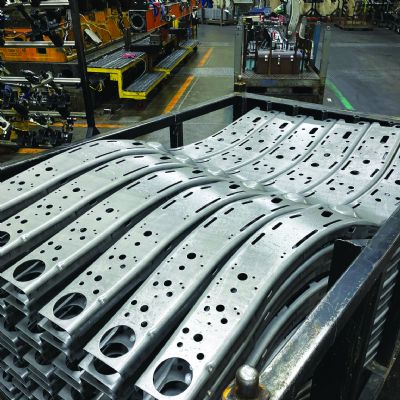Lubricant residue on parts also created adverse affects to welds and the paint pretreatment system. As a result, all parts were washed prior to these processes. Significant costs were incurred, including those related to energy consumption, cleaning chemicals and waste disposal. Finally, because the lubricant was not compatible with the plant’s waste-treatment system, much of the disposed cleaning-system effluent, mop soap, and used lubricant had to be hauled a by a waste carrier.
The Case for “Green”
Beginning in mid-2007, Martinrea Hopkinsville set out to investigate a change in lubricant. The project involved many people at the plant, but what ultimately drove its success was the involvement and commitment from top management to improve its processes.
Says Bob Sheil, the plant’s human resource manager: “Our plant general manager, Kurt Spencer, has been here since this place was a bean field. He built this building. If the roof leaks, we blame him. Likewise, he sees to the plant’s efficiency.”
 |
| Lighter lubricant residue and efficient lube application allows part handlers to more readily inspect the parts and catch defects more quickly. |
Spencer says that the project to change stamping lubricants came about with a few “bumps in the road, but we kept after it. We focused on synthetic lubricants. One company’s lubricant attacked our tool coating. You could see the run lines etching the coating.”
After testing several different lubricants, from a host of vendors, the plant settled on a heavy-duty water-soluble lubricant that does not contain chlorine or petroleum: Renoform OS 7910, from Fuchs Lubricant Co., Harvey, IL. Says Spencer: “OS 7910 costs more than did our previous oil, but we eliminated washing, we haul waste a less frequently, and our lubricant consumption has been cut in half. One lube does everything.”
Renoform OS 7910 owes its success to Fuch’s development work in Europe, which has significant restrictions on the use of chlorine and is ahead of the United States in the move toward “green” manufacturing. European efforts have focused on straight oil to replace chlorine as an extreme-pressure additive in heavy-duty lubricants, while the United States generally prefers water-miscible lubricants. The combined efforts resulted in the development of this nonpetroleum lubricant to replace chlorinated paraffin stamping lubricants in heavy-duty operations.
Pumped from a Central Mixing Station
With its change in lubricants, Martinrea sacrificed nothing in performance yet gained considerable advantages. Most parts no longer require washing before welding or paint pre-treatment, as they exit the press “virtually dry,” says Ron Shelton, who works at the plant in materials support and steel procurement. The new lubricant is compatible with the plant’s waste-treatment system, so costs related to waste disposal have dropped considerably, as the plant has gone from two to three tank wagons per week to just one per month.
The group incorporated several useful innovations that improved operations and reduced waste. The lubricant is automatically mixed in a central system and pumped to spray manifolds at each press. The manifolds feed spray nozzles hard-plumbed into each die. Each nozzle, individually programmed per job, strategically applies the lubricant to the appropriate area of a blank or stamped section. Color-coded tubing ensures that the properly programmed line is attached to the correct nozzle. With each job programmed into the central press PLC, the appropriate lube program automatically transfers.
This system provides several improvements that reduce scrap, improve tool life, and minimize lubricant use. Hard-plumbed and programmed nozzles ensure that the right amount of lubricant is applied in the right area from the first hit. Particularly with high-strength steels, a tool can be damaged in one hit if the lubricant mixture is wrong or is applied in the wrong place.
Martinrea’s system minimizes the risk of a sprayer being displaced or improperly aimed. Programmable spray nozzles also allow the plant to strategically apply the lubricant. The program has provided significant reductions in utility use, waste and wastewater disposal, potential scrap reduction and safety issues. The new lubricant operates at a lighter viscosity and allows the spray system to provide a crisp spray pattern that shuts off without dribbling.
Neater, Cleaner and Safer
The lighter lubricant residue and efficient application provides other advantages. Part handlers have noticed that their uniforms are cleaner and their gloves last longer. They report that they can see parts better and catch defects more quickly. Parts do not drip as readily from part bins to the floor as they move around the plant. These process features have reduced scrap, reduced laundry costs, and improved health and safety throughout the facility. MF
View Glossary of Metalforming Terms
See also: FUCHS Lubricants Co.
Technologies: Lubrication











 White-paper
White-paper